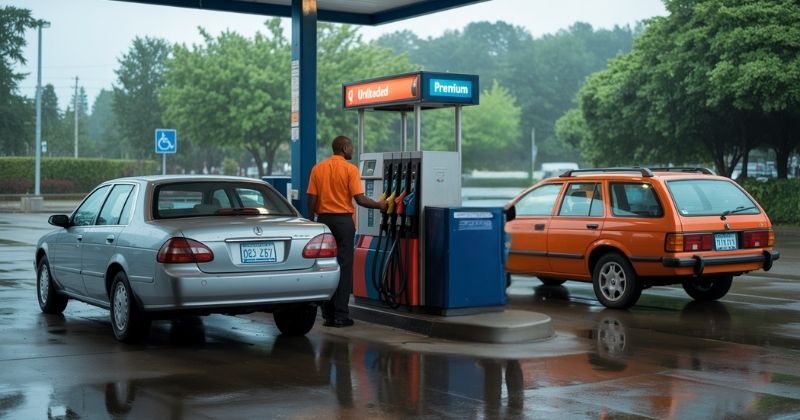
Over the past year, motorists in South Africa have experienced ongoing relief at the fuel pumps, as petrol prices have cumulatively dropped by a total of R2.90 per litre since June 2024. This decline has provided much-needed financial breathing room for households facing broader cost pressures. The Department of Petroleum and Mineral Resources has recently confirmed a modest decrease in petrol prices, which came into effect on Wednesday, 4 June 2025. This latest reduction marks the fourth consecutive petrol price cut of the year, reinforcing the positive trend observed across the 12-month period.
Key Takeaways
- R2.90 Petrol Price Drop: South African fuel prices have fallen by R2.90 per litre since June 2024. This decline has provided consistent relief to motorists and helped reduce overall transport costs.
- Stronger Rand and Global Oil Dip: The strengthening of the rand after the 2024 elections and a sharp drop in global oil prices due to US trade tensions played a major role. These factors combined to support continued fuel price cuts despite global uncertainty.
- Inflation and Interest Rate Relief: Lower fuel prices helped push inflation below 3%, well under the Reserve Bank’s target. This allowed the central bank to cut interest rates by 100 basis points since late 2024, with more reductions possible.
About Arcadia Finance
Get the loan you need with ease through Arcadia Finance. Pay zero application fees and choose from 19 trusted lenders, all registered with South Africa’s National Credit Regulator. Enjoy a smooth, secure process designed to meet your financial goals.
Early 2025 Began with Increases Amidst Global Volatility
The new year did not begin with reductions, however. Petrol prices were initially adjusted upwards in January 2025, continuing a short-lived upward trajectory that had started during the final two months of 2024. These price increases were largely influenced by global market instability that surrounded the 2024 United States presidential elections. The re-election of Donald Trump introduced renewed uncertainty into the global economic outlook, which in turn contributed to pressure on oil markets and exchange rates. This election result rattled investors and disrupted commodity pricing cycles, leading to sharp reactions in the oil and currency markets.
Local Political Developments Helped Reinforce Rand Strength
Despite the inflationary pressure brought on by international factors, these initial increases did not reverse the longer-term downward trajectory in local fuel prices. The outcome of South Africa’s national elections in May 2024 played a decisive role in strengthening the rand, which in turn supported better fuel price outcomes. While the global market context continues to shape local fuel pricing, analysts point to the formation of the Government of National Unity (GNU) as a critical moment in restoring investor confidence and enhancing currency stability. The rand’s rebound became a cornerstone in shielding South Africans from volatile import costs and record-high oil prices seen elsewhere.
As the R2.90 relief sinks in, motorists are already looking over the horizon to next month’s pump prices. Petrol Price Forecast: July shows how crude oil trends and rand‐dollar swings could nudge prices up or down.

Exchange Rate and Global Oil Trends Remain Central Factors
The strength of the rand against the US dollar has remained one of the two main determinants in the recovery of local fuel prices, alongside international oil prices. The GNU’s emergence after the May 2024 elections was seen as a positive political signal, contributing significantly to a stronger rand in the second half of the year. However, despite this boost in sentiment, continued concerns about global economic growth under the Trump administration capped the size of petrol price recoveries late in 2024, resulting in moderate increases during November and December. This delicate balance between political optimism and international uncertainty kept economists cautious heading into 2025.
Trump’s Foreign Policy Sent Shockwaves Through Currency Markets
As 2025 unfolded, the Trump administration’s sudden focus on trade and tariff issues involving South Africa created fresh volatility in the rand-dollar exchange rate. This unpredictable policy stance affected markets in the early part of the year and added complexity to fuel pricing expectations. Even amid domestic political tensions surrounding the 2025 national budget, South Africa managed to maintain relative balance in price recoveries, although the situation remained fragile.
Trump’s aggressive economic rhetoric and threats of renewed sanctions temporarily dented global sentiment toward emerging markets, dragging the rand down in sporadic bursts.
Global Oil Prices Plummet Amid US Trade Disputes
One of the more favourable global developments for South African motorists has been the substantial 15% drop in international oil prices since the beginning of 2025. Analysts have linked this decline to the Trump administration’s aggressive trade stance and tariff disputes, which have reduced global economic activity and, by extension, demand for oil. The resulting oversupply has placed downward pressure on crude prices, which has translated into noticeable savings for local consumers. Oil producers were forced to slash prices to maintain export levels, unintentionally creating breathing space for fuel-importing countries like South Africa.
Behind every cent off the pump lies a tangle of fiscal decisions. The treasury’s mid‐year budget review isn’t just numbers on a page – it’s central to why petrol swung by R2.90. Our Fuel Tax Increase & State Company Crisis guide lays out how government levies and Eskom’s woes feed into price setting.

Detailed Breakdown of Fuel Price Adjustments from June 2024 to June 2025
Over the span of twelve months, fuel prices in South Africa have shifted significantly. Petrol 93 has decreased by R2.67 per litre, while Petrol 95 has seen a more substantial reduction of R2.90 per litre. Diesel, used heavily in transport and logistics sectors, has dropped by R2.43 per litre over the same period. These savings have directly benefited logistics companies, taxi operators, and lower-income households that are most affected by transport costs.
| Month | Petrol 93 | Petrol 95 | Diesel 0.05% |
|---|---|---|---|
| Starting price (June 2024) | R23.91 | R24.25 | R20.96 |
| July 2024 | -105 | -99 | -30 |
| August 2024 | -15 | -15 | -28 |
| September 2024 | -92 | -92 | -79 |
| October 2024 | -106 | -114 | -114 |
| November 2024 | +25 | +25 | +21 |
| December 2024 | +17 | +17 | +55 |
| January 2025 | +19 | +12 | +8 |
| February 2025 | +82 | +82 | +105 |
| March 2025 | -7 | -7 | -18 |
| April 2025 | -58 | -72 | -84 |
| May 2025 | -22 | -22 | -42 |
| June 2025 | -5 | -5 | -37 |
| Ending price (June 2025) | R21.24 | R21.35 | R18.53 |
| Net change | -R2.67 | -R2.90 | –R2.43 |
These detailed monthly figures paint a clear picture of how international and domestic developments have combined to influence fuel costs over time.

Declining Fuel Prices Ease Pressure on Inflation
The sustained decrease in fuel prices has had a positive knock-on effect on South Africa’s broader economy, particularly in terms of inflation. With fuel being a major contributor to transport and goods costs, the recent declines have helped keep headline consumer price inflation (CPI) within favourable bounds. After several years of stubborn inflation, CPI has gradually fallen towards the South African Reserve Bank’s midpoint target of 4.5% and even dropped below the lower boundary of 3% in early 2025. Lower transport costs have filtered through to food prices and core goods, giving cash-strapped consumers some room to breathe.
Contrary to forecasts by many analysts, inflation has continued to surprise on the lower end, consistently remaining under the 3% mark. At its most recent meeting, the Monetary Policy Committee (MPC) of the Reserve Bank specifically credited the ongoing drop in fuel prices as a key factor in restraining inflation. Reflecting this new data, the Reserve Bank revised its inflation forecast for the year down to an average of 3.6%, compared to a previous projection of above 4.0%. This adjustment has boosted market confidence that interest rates may ease further, lifting economic growth prospects.
Interest Rate Cuts Provide Additional Relief for Borrowers
With inflation well under control, the South African Reserve Bank felt confident enough to cut interest rates by 25 basis points in May 2025, adding to the cumulative 100 basis points of easing since September 2024. If inflation remains on its current trajectory, there is a strong possibility that another 25-basis point cut could follow in the near future. This would provide further financial relief for borrowers, especially those with existing credit agreements or looking to access finance.
Looking ahead, the outlook for fuel pricing in South Africa remains cautiously optimistic. Market watchers anticipate the rand will either hold its ground or strengthen slightly, assuming political and economic stability continues. Oil markets are expected to remain turbulent due to geopolitical tensions and trade disruptions, but the overall trend points towards subdued demand and increased supply. This environment is likely to support continued affordability at the pumps for South African motorists.
Conclusion
The combination of local political stability and global economic shifts has created a favourable environment for South African fuel pricing over the past year. With the rand holding steady and international oil prices under pressure, fuel costs have dropped significantly, easing inflation and enabling interest rate cuts. These developments have not only lightened the financial load on consumers but also supported broader economic stability heading into the second half of 2025.
Fast, uncomplicated, and trustworthy loan comparisons
At Arcadia Finance, you can compare loan offers from multiple lenders with no obligation and free of charge. Get a clear overview of your options and choose the best deal for you.
Fill out our form today to easily compare interest rates from 19 banks and find the right loan for you.



